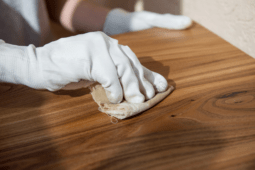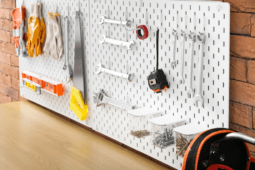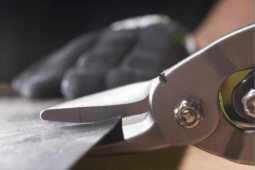How to: Repair Stripped Screw Holes in Wood

If you’ll recall from your grade school science lessons, a screw is a simple machine. It’s a continuous helix-shaped thread that cuts a groove into the surrounding material, thereby keeping the screw in place and, usually, holding two things together.
And, they work great…except when that “surrounding material” they’re supposed to cut into gets worn away, and the screw just spins and spins inside the hole, holding absolutely nothing together.
Luckily, there’s a super easy solution to fix it, and it costs about four cents and takes less than five minutes.
This is the screen door on my back entrance. Since I rent, that means it’s a piece of junk that my landlords bought twenty years ago cause it was the cheapest, and it breaks all the time. Usually, I can fix things like this with a tighten (or a kick), but last week, the channel that sits on the latch side of the door and creates a seal with the frame (anyone know what this part is called?) pulled away entirely, because the fiberboard around the screws stripped out.
Here’s how I fixed it in about four minutes for five screw holes. Since it’s crummy and no one cares how its looks, I could have just drilled a new hole and started all over again, but there are plenty of other occassions when that won’t work: DIY and furniture projects where the hardware needs to be evenly spaced; any time you’ll be able to see the original hole; or where symmetry is important, such as a kitchenb cabinet pull or knob that needs to match the others.

Note: sometimes, this can be fixed with a longer screw, where the additional threads can cut into the wood at the back of the hole. Other times, a drywall anchor will work. I didn’t have matching hardware around, so I went with this, my favorite method, which replaces the stripped out hole with actual wood for the screw to screw into.

Measure the diameter of the screw threads, and cut a small plug from a similarly sized dowel rod. Your local hardware store will have them in increments of 1/32 of an inch, so you’ll certainly be able to find one that will fit snugly. If the hole is quite small, you might also be able to use a few wooden toothpicks.

Dip the dowel in lots of wood glue, and insert into the hole. The wood glue will not only help the dowel to stick, but also causes the wood fibers to swell and fill the stripped hole perfectly. Also, since your door will interact with the elements, be sure to use a waterproof wood glue. My favorite is Titebond III.
Allow the glue to dry for a few hours, then sand the dowel, or cut with a flush cut trim saw.

Then, after the glue has dried, drill a tiny pilot hole with your smallest drill bit, and replace the screw. I was able to just use the same hardware, which was helpful, since I don’t have tons of white, hex-headed sheet metal screws in my fastener box. But, unlike the large home centers in my town, most smaller, neighborhood hardware stores have lots of odd, more specific fasteners, plus knowledgeable staff that can help you find exactly what you’re looking for…just take the old one in as an example.
That’s it! If you have dowels lying around (you should, they’re all kinds of useful; be sure to keep any scraps from other projects), this is a free fix, and can be completed in no time.










